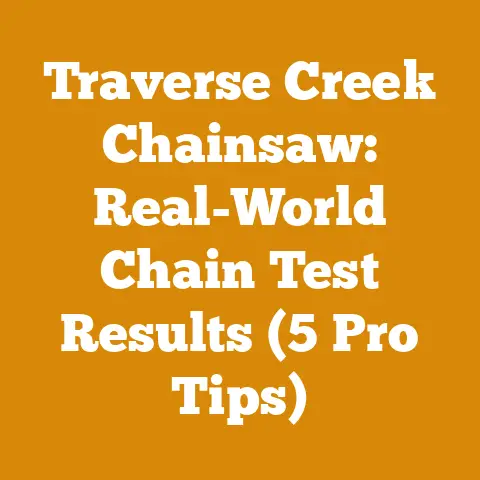Primer Bulb for Craftsman Chainsaw (5 Fixes to Boost Fuel Flow)
Introduction: The Silent Symphony of the Woods
I’ve spent years in the woods, felling trees, bucking logs, and preparing firewood.
What many people don’t realize is that a crucial element of any chainsaw’s performance, often overlooked, is the humble primer bulb.
A properly functioning primer bulb ensures a smooth start and consistent fuel flow, directly impacting efficiency and reducing unnecessary engine strain.
Think of it as the conductor of an orchestra, ensuring all instruments (engine components) play in harmony.
A malfunctioning primer bulb can turn that symphony into a cacophony of frustration.
In this guide, I’ll share my knowledge and experience on diagnosing and fixing Craftsman chainsaw primer bulb issues.
I’ve learned these fixes through trial and error, and I’m confident they’ll help you keep your saw running smoothly.
Let’s dive in!
Primer Bulb for Craftsman Chainsaw: 5 Fixes to Boost Fuel Flow
The primer bulb, that small, clear or black rubber dome on your Craftsman chainsaw, plays a vital role in getting your engine going.
It draws fuel from the tank and primes the carburetor, making starting easier, especially in cold weather.
When it fails, starting becomes a real chore.
I’ve been there countless times, yanking on the starter cord until my arm felt like it was going to fall off.
So, let’s explore the most common problems and how to fix them.
1. Identifying a Faulty Primer Bulb
The first step is understanding if the primer bulb is actually the problem.
Here’s how I typically diagnose a faulty bulb:
- Visual Inspection: Look for cracks, tears, or hardening of the rubber.
A damaged bulb won’t create a proper seal.
I’ve seen bulbs completely disintegrate after years of use. - Feel for Resistance: When you press the bulb, you should feel resistance as it draws fuel.
If it collapses easily with no resistance, it’s likely leaking or has a hole. - Check for Fuel Flow: After pressing the bulb several times, can you see fuel moving through the fuel lines?
If not, there’s a blockage or the bulb isn’t creating enough suction. - Starting Difficulty: Is your chainsaw harder to start than usual?
Does it require multiple pulls on the starter cord, even after priming? - Fuel Leaks: Are you noticing fuel leaking around the primer bulb area?
This is a clear sign of damage.
My Experience: I remember one time when my chainsaw wouldn’t start at all.
After checking the spark plug and air filter, I finally noticed a tiny crack in the primer bulb.
It was so small I almost missed it, but it was enough to prevent the saw from starting.
Takeaway: A thorough visual and functional inspection is crucial for accurate diagnosis.
2. Replacing a Cracked or Damaged Primer Bulb
Replacing a damaged primer bulb is a straightforward process, but it’s essential to do it correctly to avoid further issues.
Tools You’ll Need:
- New Primer Bulb (ensure it’s compatible with your Craftsman chainsaw model)
- Small Screwdriver or Pick
- Needle-Nose Pliers (optional)
- Clean Rags
Step-by-Step Replacement:
- Safety First: Disconnect the spark plug wire to prevent accidental starting.
Drain the fuel tank or work in a well-ventilated area to minimize fumes. - Locate the Primer Bulb: The primer bulb is usually located on the carburetor housing.
- Remove the Old Bulb: Using a small screwdriver or pick, carefully pry the old bulb from its housing.
Be gentle to avoid damaging the surrounding plastic.
Sometimes, the bulb is held in place by small barbs or a retaining ring. - Clean the Mounting Area: Wipe the mounting area with a clean rag to remove any dirt or debris.
- Install the New Bulb: Align the new bulb with the mounting hole and press it firmly into place.
Ensure it’s seated properly and securely. - Reconnect Fuel Lines (If Necessary): Some primer bulbs have integrated fuel lines.
If you disconnected any fuel lines during the removal process, reconnect them securely. - Test the Bulb: Press the bulb several times to check for proper fuel flow.
Look for any leaks around the bulb. - Reconnect Spark Plug Wire: Reconnect the spark plug wire.
- Start the Chainsaw: Attempt to start the chainsaw.
It may take a few pulls to prime the carburetor.
My Experience: I once rushed the replacement process and didn’t seat the new bulb properly.
The chainsaw started, but fuel leaked everywhere.
It was a messy and potentially dangerous situation.
Take your time and ensure the bulb is securely in place.
Important Note: When selecting a replacement primer bulb, make sure it’s the correct size and shape for your specific Craftsman chainsaw model.
Using the wrong bulb can lead to poor performance or even damage the carburetor.
Takeaway: Replacing a primer bulb is simple, but careful execution is key to a successful repair.
3. Clearing Clogged Fuel Lines
Sometimes, the primer bulb itself isn’t the problem.
A clogged fuel line can prevent fuel from reaching the bulb, making it seem like the bulb is faulty.
Tools You’ll Need:
- Small Screwdriver
- Needle-Nose Pliers
- Carburetor Cleaner or Compressed Air
- Fuel Filter (optional, if replacing)
- New Fuel Line (optional, if damaged)
Step-by-Step Cleaning:
- Safety First: Disconnect the spark plug wire and drain the fuel tank.
- Locate the Fuel Lines: Trace the fuel lines from the fuel tank to the carburetor and primer bulb.
- Disconnect the Fuel Lines: Carefully disconnect the fuel lines from the carburetor and primer bulb using needle-nose pliers or a small screwdriver.
Be mindful of fuel spillage. - Inspect the Fuel Lines: Examine the fuel lines for cracks, kinks, or other damage.
Replace them if necessary. - Clean the Fuel Lines: Use carburetor cleaner or compressed air to blow out any debris from the fuel lines.
You can also use a thin wire to gently dislodge any stubborn blockages. - Check the Fuel Filter: Many Craftsman chainsaws have a small fuel filter inside the fuel tank.
Remove the filter and inspect it for clogs.
Replace it if it’s dirty or damaged.
I usually replace mine annually, regardless of appearance. - Reassemble the Fuel Lines: Reconnect the fuel lines to the carburetor and primer bulb, ensuring they are securely attached.
- Test the Primer Bulb: Press the primer bulb several times to check for proper fuel flow.
- Reconnect Spark Plug Wire: Reconnect the spark plug wire.
- Start the Chainsaw: Attempt to start the chainsaw.
My Experience: I once spent hours trying to diagnose a starting problem, only to discover a tiny piece of debris lodged in the fuel line.
A quick blast of compressed air solved the issue.
Important Note: When working with fuel lines, be careful not to damage them.
Old fuel lines can become brittle and crack easily.
Takeaway: Clogged fuel lines can mimic a faulty primer bulb.
Cleaning or replacing them is a simple but often overlooked fix.
4. Addressing a Leaky Carburetor
A leaky carburetor can cause fuel to drain away from the primer bulb, making it difficult to start the chainsaw.
While a full carburetor rebuild is sometimes necessary, addressing the symptoms can often resolve the issue.
Tools You’ll Need:
- Carburetor Cleaner
- Screwdrivers (various sizes)
- Carburetor Adjustment Tool (if necessary)
- Clean Rags
Step-by-Step Inspection and Cleaning:
- Safety First: Disconnect the spark plug wire and drain the fuel tank.
- Visually Inspect the Carburetor: Look for any signs of fuel leakage around the carburetor body, gaskets, and fuel lines.
- Clean the Carburetor Exterior: Use carburetor cleaner and a clean rag to remove any dirt or grime from the carburetor exterior.
- Check Carburetor Mounting Bolts: Ensure the carburetor mounting bolts are tight.
Loose bolts can cause air leaks, affecting fuel flow. - Adjust Carburetor Settings (If Necessary): Refer to your chainsaw’s owner’s manual for instructions on adjusting the carburetor settings.
Improperly adjusted settings can cause fuel starvation or flooding.
Note: I only adjust the carburetor as a last resort, and only after carefully documenting the original settings. - Check the Gaskets: Inspect the carburetor gaskets for cracks or damage.
Replace them if necessary. - Test the Primer Bulb: Press the primer bulb several times to check for proper fuel flow.
- Reconnect Spark Plug Wire: Reconnect the spark plug wire.
- Start the Chainsaw: Attempt to start the chainsaw.
My Experience: I had a chainsaw that would start and run fine for a few minutes, then stall.
It turned out the carburetor mounting bolts were loose, causing an air leak.
Tightening the bolts solved the problem.
Important Note: Carburetor adjustments can be tricky.
If you’re not comfortable making adjustments, consult a qualified chainsaw mechanic.
Takeaway: A leaky carburetor can indirectly affect the primer bulb’s performance.
Addressing leaks and ensuring proper settings can improve fuel flow.
5. Diagnosing and Fixing a Vacuum Leak
A vacuum leak anywhere in the fuel system can prevent the primer bulb from drawing fuel effectively.
This is because the primer bulb relies on creating a vacuum to pull fuel from the tank.
Tools You’ll Need:
- Carburetor Cleaner
- Spray Bottle
- Small Screwdriver
- New Fuel Lines (optional)
Step-by-Step Leak Detection:
- Safety First: Disconnect the spark plug wire and drain the fuel tank.
- Prepare a Soapy Water Solution: Mix a small amount of dish soap with water in a spray bottle.
- Spray the Fuel Lines and Connections: Spray the soapy water solution on all fuel lines, connections, and around the carburetor and primer bulb.
- Observe for Bubbles: Start the chainsaw (if possible) or manually prime the bulb.
Look for bubbles forming in the soapy water solution.
Bubbles indicate a vacuum leak. - Tighten Connections or Replace Parts: If you find a leak, try tightening the connection.
If the leak persists, replace the fuel line or gasket. - Check the Fuel Tank Vent: A blocked fuel tank vent can also create a vacuum problem.
Ensure the vent is clear and allows air to enter the tank. - Test the Primer Bulb: Press the primer bulb several times to check for proper fuel flow.
- Reconnect Spark Plug Wire: Reconnect the spark plug wire.
- Start the Chainsaw: Attempt to start the chainsaw.
My Experience: I had a chainsaw that would run fine at high RPMs but would stall at idle.
After checking everything else, I discovered a small crack in the fuel line near the fuel tank.
The crack was so small I almost missed it, but it was enough to cause a vacuum leak.
Replacing the fuel line solved the problem.
Important Note: Vacuum leaks can be difficult to find.
Be patient and thorough in your inspection.
Takeaway: Vacuum leaks can sabotage the primer bulb’s ability to draw fuel.
Identifying and fixing these leaks is crucial for proper engine operation.
Maintaining Your Chainsaw for Optimal Performance
Beyond these specific fixes, regular chainsaw maintenance is crucial for preventing primer bulb and fuel system problems.
Here are some of my key practices:
- Use Fresh Fuel: Old fuel can break down and clog fuel lines and carburetors.
I always use fresh fuel mixed with the correct ratio of 2-cycle oil.
I try to use up fuel within 30 days or add a fuel stabilizer. - Clean Air Filter Regularly: A dirty air filter restricts airflow, which can affect fuel mixture and make starting difficult.
I clean mine after every use. - Sharpen the Chain Regularly: A dull chain puts more strain on the engine and can lead to overheating.
I sharpen my chain every time I refuel. - Store Chainsaw Properly: When storing your chainsaw for extended periods, drain the fuel tank and run the engine until it stalls.
This prevents fuel from gumming up the carburetor. - Inspect Fuel Lines Regularly: Check fuel lines for cracks, kinks, or other damage.
Replace them as needed. - Replace Fuel Filter Annually: As mentioned earlier, I replace my fuel filter annually to ensure a clean fuel supply.
- Follow Manufacturer’s Recommendations: Always follow the manufacturer’s recommendations for maintenance and repair.
Chainsaw Safety: A Paramount Concern
Working with chainsaws is inherently dangerous.
I always prioritize safety and urge you to do the same.
Here are some essential safety precautions:
- Wear Appropriate Safety Gear: Always wear safety glasses, hearing protection, gloves, and sturdy boots.
I also recommend wearing chainsaw chaps to protect your legs. - Work in a Safe Area: Ensure you have a clear and stable working area.
Be aware of your surroundings and avoid working near power lines or other hazards. - Use Proper Cutting Techniques: Learn and practice proper cutting techniques to avoid kickback and other dangerous situations.
- Maintain Your Chainsaw Properly: A well-maintained chainsaw is a safer chainsaw.
Keep the chain sharp, the air filter clean, and the fuel system in good working order. - Never Work Alone: It’s always best to work with someone else, especially when felling trees.
- Take Breaks: Chainsaw work can be physically demanding. Take frequent breaks to avoid fatigue.
- Know Your Limits: Don’t attempt tasks that are beyond your skill level.
Conclusion: Empowering Your Chainsaw Maintenance
The primer bulb is a small but critical component of your Craftsman chainsaw’s fuel system.
By understanding its function and common problems, you can troubleshoot issues and keep your saw running smoothly.
Remember to prioritize safety and perform regular maintenance to prevent problems from occurring in the first place.
I hope this guide has empowered you to tackle primer bulb issues and keep your chainsaw in top condition.
Happy cutting!






